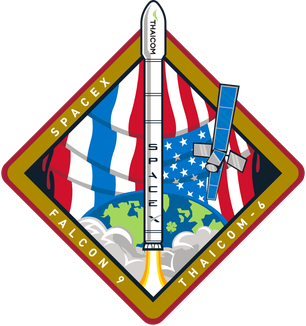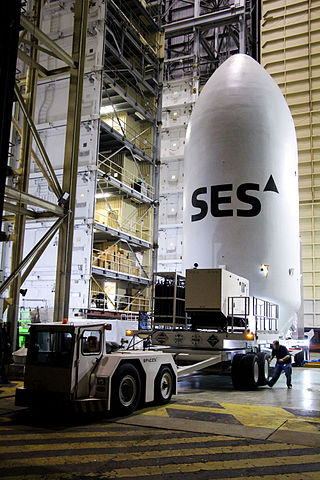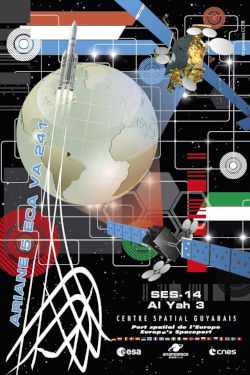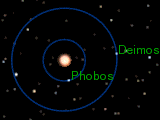
Ariane 5 is a European heavy-lift space launch vehicle developed and operated by Arianespace for the European Space Agency (ESA). It is launched from the Centre Spatial Guyanais (CSG) in French Guiana. It has been used to deliver payloads into geostationary transfer orbit (GTO) or low Earth orbit (LEO). The launch vehicle had a streak of 82 consecutive successful launches between 9 April 2003 and 12 December 2017. Since 2014, Ariane 6, a direct successor system, is in development.

A geosynchronous orbit is an Earth-centered orbit with an orbital period that matches Earth's rotation on its axis, 23 hours, 56 minutes, and 4 seconds. The synchronization of rotation and orbital period means that, for an observer on Earth's surface, an object in geosynchronous orbit returns to exactly the same position in the sky after a period of one sidereal day. Over the course of a day, the object's position in the sky may remain still or trace out a path, typically in a figure-8 form, whose precise characteristics depend on the orbit's inclination and eccentricity. A circular geosynchronous orbit has a constant altitude of 35,786 km (22,236 mi).

A geostationary orbit, also referred to as a geosynchronous equatorial orbit (GEO), is a circular geosynchronous orbit 35,786 km (22,236 mi) in altitude above Earth's equator and following the direction of Earth's rotation.
A synchronous orbit is an orbit in which an orbiting body has a period equal to the average rotational period of the body being orbited, and in the same direction of rotation as that body.

A low Earth orbit (LEO) is an orbit around Earth with a period of 128 minutes or less and an eccentricity less than 0.25. Most of the artificial objects in outer space are in LEO, with an altitude never more than about one-third of the radius of Earth.

A geosynchronous transfer orbit or geostationary transfer orbit (GTO) is a type of geocentric orbit. Satellites that are destined for geosynchronous (GSO) or geostationary orbit (GEO) are (almost) always put into a GTO as an intermediate step for reaching their final orbit.
A geocentric orbit or Earth orbit involves any object orbiting Earth, such as the Moon or artificial satellites. In 1997, NASA estimated there were approximately 2,465 artificial satellite payloads orbiting Earth and 6,216 pieces of space debris as tracked by the Goddard Space Flight Center. More than 16,291 objects previously launched have undergone orbital decay and entered Earth's atmosphere.
The areosynchronous orbits (ASO) are the synchronous orbits for artificial satellites around the planet Mars. They are the martian equivalent of the geosynchronous orbits (GSO) on the Earth. The prefix areo- derives from Ares, the ancient Greek god of war and counterpart to the Roman god Mars, with whom the planet was identified. The modern Greek word for Mars is Άρης (Áris).

A graveyard orbit, also called a junk orbit or disposal orbit, is an orbit that lies away from common operational orbits. One significant graveyard orbit is a supersynchronous orbit well beyond geosynchronous orbit. Some satellites are moved into such orbits at the end of their operational life to reduce the probability of colliding with operational spacecraft and generating space debris.
GSAT-3, also known as EDUSAT, was a communications satellite which was launched on 20 September 2004 by the Indian Space Research Organisation. EDUSAT is the first Indian satellite built exclusively to serve the educational sector. It is mainly intended to meet the demand for an interactive satellite-based distance education system for the country.
GSAT-1 was an experimental communications satellite launched aboard the maiden flight of the GSLV rocket. The spacecraft was equipped with instrumentation to test Pulse-code modulation (PCM) transmitting on S-band frequencies and transponders operating in the C-band. The spacecraft was unable to complete its mission after a launch failure left it in a lower than planned orbit and propulsion issues prevented the satellite from correcting this via its own maneuvering system.
A subsynchronous orbit is an orbit of a satellite that is nearer the planet than it would be if it were in synchronous orbit, i.e. the orbital period is less than the sidereal day of the planet.
A parking orbit is a temporary orbit used during the launch of a spacecraft. A launch vehicle boosts into the parking orbit, then coasts for a while, then fires again to enter the final desired trajectory. The alternative to a parking orbit is direct injection, where the rocket fires continuously until its fuel is exhausted, ending with the payload on the final trajectory. The technology was first used by the Soviet Venera 1 mission to Venus.

An apogee kick motor (AKM) is a rocket motor that is regularly employed on artificial satellites to provide the final impulse to change the trajectory from the transfer orbit into its final orbit. For a satellite launched from the Earth, the rocket firing is done at the highest point of the transfer orbit, known as the apogee.
Thaicom 5 was a geostationary communications satellite operated by Thaicom. It was used to provide communications services to Asia, Africa, Middle East, Americas, Europe and Australia.

THAICOM 6 is a Thai satellite of the Thaicom series, operated by Thaicom Public Company Limited, a subsidiary of INTOUCH headquartered in Bangkok, Thailand. THAICOM 6 is colocated with Thaicom 5 at 78.5 degrees East, in geostationary orbit. The total cost for the satellite is US$160 million.

SES-9 is a geostationary communications satellite operated by SES S.A. It was launched from Cape Canaveral SLC-40 by a Falcon 9 Full Thrust launch vehicle on 4 March 2016.

Ariane flight VA241 was an Ariane 5 space launch that occurred from the Guiana Space Centre on 25 January 2018 at 22:20 UTC.









